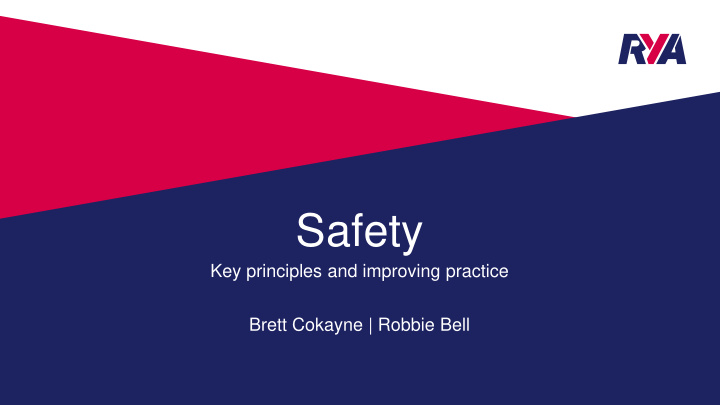



Safety Key principles and improving practice Brett Cokayne | Robbie Bell
Say hello to the person next to you • name, • club / centre, • role
Safety awareness Assurance and visibility Continuous learning
A safety management system Four corner stones • Systematic • Proactive • Explicit
Shout out: Who might have requirements for a safety team to be well trained and qualified? In groups of 5-6 people: What might a disabled person who is new to sailing expect of a safety team?
Safety team - what might sailors expect? • competent, • qualified, • knowledgeable, • has the right kit, • knows how to tow, • knows how to rescue, • first aid qualified, • correct number on the water, • adaptable, disciplined, vigilant, knows the venue, • knows what to do in an emergency and all situations, • able to help all people on the water (people and boats), • good communicator, knows who is on the water and what they need
In groups of 5-6 people a) Half the groups What are all the things you personally can do to meet the expectations of sailors and reassure them that you are a safe person? b) The other half of the groups What are all the things your club / centre / group can do to meet the expectations of sailors and reassure them you are live and breathe a culture of safety?
A safe person has the authority, sense of duty and ability to take immediate action in the interest of safety Know what support is available on the day – who is in charge, what other people and boats are available Supervision Ask for feedback on how you are performing Be vigilant to your own safety and that of others Vigilant Keep your head out of the safety boat and anticipate what might happen Listen, always be ready to help, support and respect others in the team, contribute ideas, be reliable, solve Good team member problems quickly and efficiently Get the right knowledge, ability and skills; get trained and qualified. Competent Capable Powerboat driving should be unconsciously competent; make good decisions around safety techniques and Performer procedures Assess whether you are fit and healthy enough for what you may need to do in all conditions. Assess situations calmly and efficiently. Adaptable Be able to respond to changing circumstances. Disciplined Work within the framework of systems and procedures you have been given Draw on and learn from past experience Experience and personal development Be committed to your own personal development and get access to training and learning opportunities Have the right kit ready to hand and know how to use it (including under pressure) Personal equipment Ensure the equipment is in good working order Be familiar with the operating procedures; Find out if any of the sailors have specific needs while on the water Be familiar with the boats and equipment being used on the water – rig, de-rig, de-power. Informed Be familiar with the operating area
A guided conversation
Safety • a series of decisions and judgements about if and how an activity should proceed • variables • the person (people) • the situation • the staff / volunteers supporting the activity • a guided conversation between all parties can provide the information needed to make good decisions
A guided conversation A series of prompts. Filter the sort of questions or prompts we use. The person is at the heart of the conversation – include them, give them a safe and private environment to discuss their needs. Include others who know the person well in the conversation It is hard to capture the richness of a person’s life on a form.
Take a copy of the ‘guided conversation’ handout In your own time, after the session Are these the right questions? Is anything missing? Send feedback to joff.mcgill@rya.org.uk Shout out What processes do you have in place for having these conversations with sailors?
Guided conversation - summary • Part of the dynamic risk assessment that goes on all the time • It can inform decisions about whether to sail, the level of supervision, the equipment and resources needed • Lots of people are involved in delivery activity safely – important to asses: • The competence and experience they have / need • The questions they want answered and the training they need • Sharing information about the sailors on a need to know basis
Scenarios
Groups 4-5 people 15 minutes – work through a scenario Answer the questions Capture key points from your discussion You will be asked to feedback: • Key points and decisions • Further support and guidance you need
Summary • Safety needs a systematic approach and safe people • Plan for what might happen, test your procedures • Preparation and familiarisation are key – of people and of vessels • RYA Level 2 and Safety Boat courses are really valuable. Refreshing skills continuously is key. • Continuous learning means we must be open about accidents, incidents and near misses • Let us know if there is any information, advice or guidance you need from the RYA. • There are a range of learning and training opportunities scheduled – do look at the Calendar if and let us know if you need something not listed.
Recommend
More recommend